 Uranus Symbol |
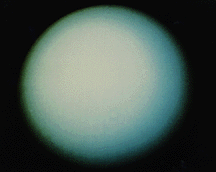 |
 Uranus Symbol |
 |
 Sir William
Herschel (1738-1822). Image © Copyright Royal Astronomical
Society.
Sir William
Herschel (1738-1822). Image © Copyright Royal Astronomical
Society.
The first of the planets to be "discovered" was named after the muse of Astronomy (Urania). Uranus is also the name of Saturn's father. Uranus was discovered by William Herschel in 1781, though it had been mistakenly mapped in the past as a star. It is possible under the correct conditions to see Uranus with your just eye (no telescope), though it is pretty difficult to do, and you would need to have good eyesight and know exactly where to look to see it. Of course, you have to pronounce the name correctly. If you say something that sounds like "yer-anus," I don't think you'll make too many friends that way, unless they are proctologists. You should instead say the name as "yer-ah-nis" - not much of an improvement, but it may help.
Uranus is so far away that we can't get a great deal of information on it from this distance. A few things we can see are its tilt and rotation rate. Uranus is pretty much tipped over on its side. You know that the Earth is tilted over 23 1/2 degrees; Uranus is tilted over 98 degrees! This means it is on its side (since being 90 degrees would be exactly on its side). Due to this the seasons on Uranus are pretty extreme, especially if you are located at one of the poles. It takes Uranus about 84 years to go around the Sun, so the seasons last for about 21 years. If you were located at one of the poles, you would have 21 years of constant daylight during summer and 21 years of continual darkness during the winter. The temperatures would be pretty extreme. Not only is the planet tilted over, but the rings and satellites are also in tilted orbits about Uranus. It is likely that early in its history the planet was knocked over by an impact and as the system formed (as the satellites and rings formed), they also ended up in tilted orientations.
 Figure 1. The orbit and tilt of Uranus are shown.
Uranus is tilted pretty much on its side, so there are times when only
certain parts of it will get any sunlight. This is especially true for
the polar regions.
Figure 1. The orbit and tilt of Uranus are shown.
Uranus is tilted pretty much on its side, so there are times when only
certain parts of it will get any sunlight. This is especially true for
the polar regions.
There are several very thin rings around Uranus. The rings were discovered from the Earth by accident in 1977. Astronomers were trying to study the atmosphere of the planet by watching how the light of a star would change (get absorbed by the atmosphere) as the planet moved in front of it. Before the star was anywhere close to the planet, the star's brightness faded several times. This happened again when the star was located on the other side of the planet. Now it is possible that the star could have been eclipsed by some moons, but that would have required some very precise alignments of the moons with the distant star. Rings were the cause for the dimming of the starlight! The rings are rather similar to Jupiter's ring in that they are made of darker material as well as small microscopic particles - stuff like dust. Uranus actually has 11 main rings, far fewer than Saturn.
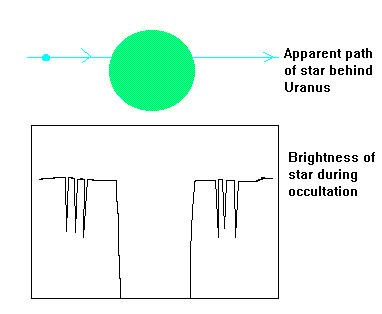 Figure 2.
The dimming of a star's light as it approached Uranus indicated that there
are rings around Uranus.
Figure 2.
The dimming of a star's light as it approached Uranus indicated that there
are rings around Uranus.
Viewing Uranus from the Earth doesn't provide much information, so let's send a spacecraft out there. Actually, we have - the only spacecraft to visit Uranus was Voyager 2 in January of 1986. The other Voyager spacecraft did not visit any other planets after its encounter with Saturn, while Voyager 2 continued on to Uranus and Neptune. All of the up close images we have of them are from that one spacecraft. What did it see?
When Voyager 2 flew by Uranus, there were no cloud features (spots) as had been seen on Jupiter and Saturn. In fact, there are no markings at all; the atmosphere of Uranus appeared to be very dull. This was really surprising, since at the time that the Voyager spacecraft flew by Uranus, one of the poles was pointed toward the Sun. Astronomers thought that this would have caused the atmosphere to heat up a great deal and therefore produce a bunch of storms. It was a bit confusing when all the Voyager images were so dull. When we look at Uranus today with the Hubble Space telescope, there are cloud features visible. The atmosphere appears to change as it orbits the Sun.
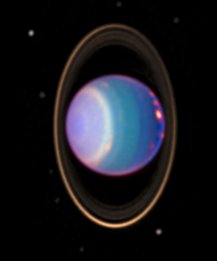 Figure 3. The view of Uranus as seen by the Hubble
Space Telescope. This differs from the Voyager view from 1986, which
showed no cloud features. The clouds seen here as the pinkish features
have been observed since the mid-1990s. Image credits: Erich Karkoschka
(University of Arizona) and NASA.
Figure 3. The view of Uranus as seen by the Hubble
Space Telescope. This differs from the Voyager view from 1986, which
showed no cloud features. The clouds seen here as the pinkish features
have been observed since the mid-1990s. Image credits: Erich Karkoschka
(University of Arizona) and NASA.
What is the inside of Uranus like? (You'll want to make sure you pronounce Uranus correctly if you ever ask anyone that question.) The discussions of Jupiter and Saturn showed how similar those two objects are to one another. The same is true for Uranus and Neptune, so most of the stuff I say here about Uranus also applies to Neptune. From the observations of the Voyager spacecraft we know that Uranus is similar to Jupiter and Saturn in some respects, though there are some drastic differences. First of all, while Saturn and Jupiter are 100s of times more massive than the Earth, Uranus (and Neptune) are only about 15 times more massive than the Earth and their radii are only about 5 times greater than the Earth's. Their internal structures are also different. Just check out Figure 4.
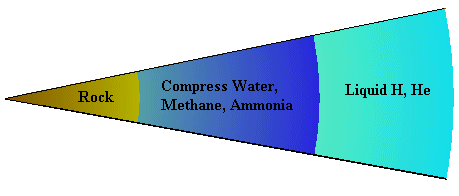 Figure 4.
The internal structure of Uranus is shown. The main difference between
Uranus (and Neptune) and Jupiter (and Saturn) is the large liquid water
ocean that exists under the upper atmosphere.
Figure 4.
The internal structure of Uranus is shown. The main difference between
Uranus (and Neptune) and Jupiter (and Saturn) is the large liquid water
ocean that exists under the upper atmosphere.
Uranus is rather cool; unlike Jupiter and Saturn, there is not any excess heat coming from its interior. Remember, Jupiter and Saturn are both hot because they haven't cooled off. Uranus, being much smaller, has had the time to cool down completely. When you look at the top of the atmosphere of Uranus, it has a rather nice blue-green color. This is due to methane in the upper atmosphere. While this is only a small part of the overall composition of these layers, it is enough to provide the color. It is sort of interesting that most of the inside of Uranus is not made up of just regular hydrogen but is comprised of hydrogen compounds (remember, water, methane and ammonia all have hydrogen in them).
Is there a magnetic field? Yes, but it is very strange. The magnetic axis does not go through the center of the planet and it is not located anywhere near the rotation axis. It is both off center and off axis. This produces a rather unusual wobble in the magnetic field as the planet rotates once every 16 hours. In terms of strength, the field is about 50 times stronger than the Earth's. Check out this animation to see what is happening.
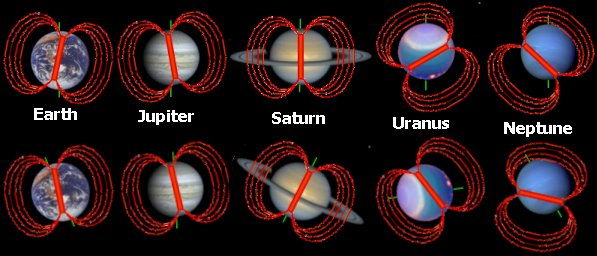 Figure 5. The alignments of the Earth's and the
jovian planets' magnetic fields are shown. The top row shows each planet
with no axis tilt - so that their rotation poles are all oriented the
same. The bottom row shows each planet with its normal tilt. The
magnetic axes are indicated by the red lines, while the rotation axes
are shown with green lines. There is only about a 10 degree difference
between these two axes for the Earth and Jupiter, while Saturn's axes
are completely in line. Both Uranus and Neptune have a huge difference
in the alignments of their magnetic and rotation axes. Also, note how
the "magnet" doesn't go through the center of Uranus or Neptune but is
off to the side. Of course, there really are no giant magnets in the
cores of planets, this just shows the alignment of the magnetic fields
with the rotation axis.
Figure 5. The alignments of the Earth's and the
jovian planets' magnetic fields are shown. The top row shows each planet
with no axis tilt - so that their rotation poles are all oriented the
same. The bottom row shows each planet with its normal tilt. The
magnetic axes are indicated by the red lines, while the rotation axes
are shown with green lines. There is only about a 10 degree difference
between these two axes for the Earth and Jupiter, while Saturn's axes
are completely in line. Both Uranus and Neptune have a huge difference
in the alignments of their magnetic and rotation axes. Also, note how
the "magnet" doesn't go through the center of Uranus or Neptune but is
off to the side. Of course, there really are no giant magnets in the
cores of planets, this just shows the alignment of the magnetic fields
with the rotation axis.
What produces the magnetic fields of Uranus and Neptune? Unlike the terrestrial planets, there are not large amounts of iron and metal, and unlike Jupiter and Saturn there aren't layers of liquid metallic hydrogen. Take a look at the image showing the interior of Uranus - what material in there could conduct electricity? If you know that you aren't supposed to have electrical appliances near water, then you should guess that the water would be the most likely one to produce the magnetic field. It appears that the magnetic field is produced by electrically charged water in the huge water layer. The high pressures on the water cause it to be electrically charged.
Satellites - Like other Jovian planets, most of the satellites around Uranus fall into the puny category (less than 300 km in diameter). They are, for the most part, dark, small, icy worlds. The ices seen on their surfaces are in various forms including water, ammonia, and methane ice. As has been seen on other satellites, they have quite a few craters and there are some ice flow features. Voyager flew by when one of the poles of Uranus was pointed toward the Sun, so the satellites where also in that same orientation. Therefore we have pictures of only 1/2 the surfaces of these worlds.
Five satellites were known of before the Voyager 2 probe flew by. These were Miranda, Ariel, Umbriel, Titania, and Oberon. The Voyager 2 spacecraft discovered 10 more, and they were named Cordelia, Ophelia, Bianca, Cressida, Desdemona, Juliet, Portia, Rosalind, Puck, and Belinda. In case you haven't figured it out, the moons are named after characters from William Shakespeare and Alexander Pope. Twelve more moons have been discovered since the Voyager mission bringing the total to 27. It's a good thing that Shakespeare and Pope had a lot of characters or else we'd run out of names.
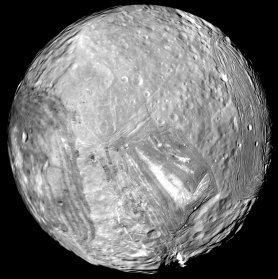 Figure 6.
The surface of Miranda.
Figure 6.
The surface of Miranda.
There is always one satellite that is unusual. In the case of Uranus, the unusual satellite is Miranda. While this is not a very large object, only about 470 km wide, it does show some very unusual surface features. These include some large circular patterns on its surface and abrupt color variations. There is also a very large cliff visible (Verona Chasm, 5 km high). Why is it so screwy? It is possible that after the moon formed, it was broken up and then reformed in a jumbled mess. It is also possible that there is a great deal of tidal heating and this may have rearranged the features on Miranda, or at least allowed them to be a bit mobile. It should be noted that Miranda is the closest of the major moons to Uranus, so it would have experienced the most tidal heating.
Several of the other moons are a bit mysterious. Ariel and Umbriel both appear to be the same size, yet Ariel's surface shows evidence of ice volcanism and tectonics, while Umbriel's surface is just full of craters. Titania and Oberon also appear to be very similar in size, and Titania appears to have had much more activity on its surface. It was thought that worlds of similar size should have similar natures, yet this small sample of worlds shows quite drastic differences - just more of those annoying mysteries we have yet to solve.
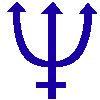 Neptune Symbol |
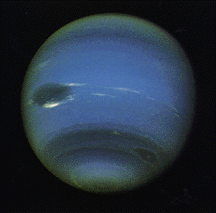 |
The last of the jovian planets was named after the god of the oceans. It was discovered in 1846 by people using mathematics. What? You mean math is actually good for something? Of course it is. Any ways, here's what happened - once Uranus was discovered, people started to observe it and plot its orbit. They noticed that its motion wasn't exactly correct; that it deviated slightly from Kepler's and Newton's laws of how things move. This would happen if there was another object out there pulling on it. This led John Adams, an English astronomer, to calculate where a planet should be based upon the unusual motions of Uranus. A little bit later, Urbain Le Verrier, a French astronomer, did pretty much the same calculations, and his results were published (Adams's calculations were pretty much ignored). The published results of Le Verrier were used by Johann Galle, a German astronomer, who used the information from Le Verrier to search for the planet. He found it (quite easily)! Who actually discovered Neptune? Credit for the discovery of the planet is given to both Adams and Le Verrier, since without their work Galle would have never seen it.
 |
 |
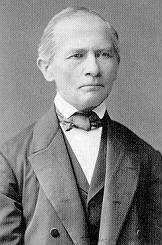 |
| Left to right, John Couch Adams (1819-1892), Urbain Jean Joseph Le Verrier (1811-1877) and Johann Gottfried Galle (1812-1910). Adams and Le Verrier are credited with the discovery of Neptune. | ||
It is also possible that Galileo saw it hundreds of years before Galle, since some of his diagrams indicate an object where Neptune would have been at the location he was observing. He would have probably mistaken it for a star.
The only spacecraft to go by Neptune was Voyager 2, which flew by in August 1989. Neptune is quite a long ways out there and the fact that the spacecraft lasted long enough to get there was quite amazing (it was launched in 1977). Also, the path that it was on as it flew by Neptune was very precise. If you were to scale the flight path down to a golf putt, the accuracy of the path was the equivalent of sinking a putt from 3630 km (2260 miles) away. That's accurate! The images from the Voyager 2 spacecraft look a little strange, in part because the spacecraft is traveling so fast and it has to take fairly long exposures, since there is not a lot of sunlight out at that distance. Now the spacecraft is on its way to the outer parts of our solar system, which it won't get out of for a few thousand more years (even though it is traveling at about 38,500 mph)
While Neptune is pretty similar to Uranus in terms of its composition, structure and density, there are some subtle differences. One area where it is quite different is in the atmospheric features observed by Voyager 2. The Great Dark Spot was observed on Neptune. This is a storm like feature about the size of the Earth. It appears to have been similar in many respects to the Great Red Spot on Jupiter (proportionally about the same size). Current observations by the Hubble Space Telescope indicate that the Great Dark Spot is no longer present (I guess it wasn't so great) and other spots have appeared. It appears that Neptune's atmosphere is much more active compared to Uranus's.
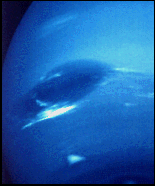 |
Figure 7. To the left is an image of the Great Dark Spot as photographed by the Voyager 2 spacecraft in 1989. On the right is an image of Neptune obtained by the Hubble Space Telescope in 1996. The Great Dark Spot is no longer visible, but other spots appear that weren't seen by Voyager. Images from NASA and Lawrence Sromovsky (University of Wisconsin-Madison). | 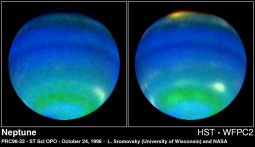 |
The Voyager images also showed other higher altitude clouds as well as smaller spots. Many of these can't be seen from the Earth with the Hubble Space Telescope, but large changes in the atmosphere of Neptune are visible. As with Uranus, the color of Neptune is due to methane in its atmosphere, even though the main components of the atmosphere are hydrogen and helium.
As mentioned previously, it appears that the internal structure is much like that of Uranus, and the magnetic field is also like that of Uranus (tilted 47 degrees from the rotation axis and off center). The strength is a bit weaker than Uranus's, though, only about 35x the Earth's magnetic field strength. You have to remember that Neptune itself is not tilted over like Uranus. A rather major difference between Uranus and Neptune is that Neptune has an internal heat source (Uranus doesn't). This heat may be left over from the planet's formation, but that seems unlikely considering that Neptune is not that large (like Jupiter and Saturn). We are still not quite sure why there is still so much heat in Neptune and none in Uranus, but the heat in Neptune does help to explain the greater activity in its atmosphere, since heat helps to produce turbulence in the atmosphere, which leads to the formation of storms and spots. One rather surprising feature of Neptune's atmosphere was the high wind speed observed - it can go up to 2000 km/h (1200 mph).
Like the other jovian planets, Neptune has rings. This wasn't known for certain until Voyager 2 went out there. Neptune isn't tilted like Uranus, so the rings could not be seen in the same way they were around Uranus. However, when astronomers did try to find rings using the variation of star light around Neptune, they tended to get conflicting results. Sometimes it looked rings were there; other times it looked as if there were no rings. This inconsistent result is due to the presence of not only rings but also ring arcs, which are thicker parts of rings. The ring arcs would block light very well, so they would at times give the indication that there were rings, but since they didn't extend all of the way around, the expected ring effects (dimming of background stars) weren't seen everywhere. Like the rings of Uranus, the rings of Neptune are made up of dark material.
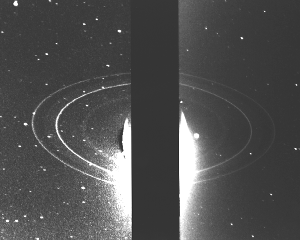 |
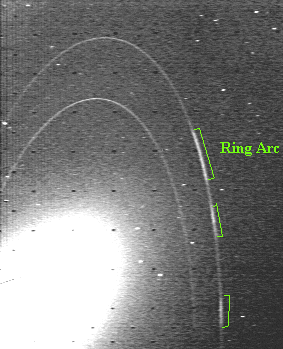 |
| Figure 8. The rings of Neptune are seen above in a very long exposure image. The rings are made up of dark material, so it is easier to see them in over exposed pictures - but you have to remove Neptune from the pictures. The image on the right shows an up close view with the ring arcs clearly visible. Image from NASA. |
Neptune has the fewest number of satellites amongst the jovian planets. Before the Voyager 2 spacecraft visited, we knew of two satellites Triton, and Nereid. Voyager 2 discovered six new ones, which are named Naiad, Galatea, Thalassa, Larissa, Proteus, and Despina. Since then, five more were discovered but have yet to be named. Either way, this gives us a grand total of 13 satellites. The theme here is to name them after water deities (which fits in well with the whole ocean god thing). As usual, most are pretty dull - just small, icy worlds with lots of craters. As usual, there is an exception - one strange world.
 |
Figure 9. Triton, the largest of Neptune's satellites, is shown (left). Note the strange color of its surface features. An up close view of the surface is seen on the right. Note the dark streaky parts that are thought to be due to ice geysers. Image from NASA. | 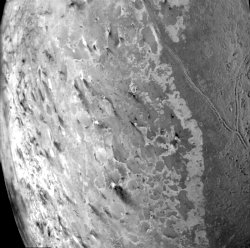 |
The largest of the Neptunian satellites is Triton. Not only is it large, but it doesn't act normally. It is in a rather bizarre orbit, since it actually goes clockwise (rather than counterclockwise) around Neptune, which is usually only seen in satellites that are small, puny and thought to be captured. To have a large satellite traveling in the wrong direction is a bit of a mystery. The really freaky thing about Triton, though, is its surface. There are not very many large craters and there does appear to be evidence of resurfacing. One of the more interesting items observed by Voyager 2 were cracks and streaks in the ice, possibly produced by ice volcanoes - ice volcanoes?! It seems that there are active volcanoes (or perhaps we should say geysers) that are erupting mainly nitrogen and methane gas and also methane ice onto the surface. The very thin atmosphere of Triton causes these particles to drift down wind and leave long, streaky marks on the surface. Triton's thin atmosphere is composed mainly of nitrogen and methane. Triton also has the coldest surface temperature yet measured on a solar system object, only 37 K (-393 degrees F).
What is Triton's problem? Why does it have activity? What do you need to have such action? HEAT! For the most part, little worlds shouldn't be hot unless something is heating them. It is thought that the heating could be due to the tidal forces exerted by Neptune. Triton's orbit is not only backwards but also rather elliptical. This means that it gets pretty close to Neptune and gets pulled pretty strongly by Neptune's tidal forces. This can cause some major internal problems in poor little Triton. Of course, when it gets far from Neptune, the heating is diminished so that it freezes up its surface again until the next heating episode. As with many things, this is just a theory.
In 1930 an object was discovered beyond Neptune and was named Pluto. In 1951, Gerard Kuiper proposed that there was a region beyond Neptune where objects that could become comets may originate from (we'll get to comets in the next set of notes, so don't get all excited just yet). In 1992 the first object to fit Kuiper's theory was found in what is now called the Kuiper Belt. Some could argue that Pluto was the first Kuiper belt object, but initial findings found that the objects discovered there were much smaller than Pluto, so Pluto was still considered a planet. To date, about 1000 of these objects (sometimes also refered to as Trans-Neptunian Objects) have been found. It is thought that there may be millions of these objects out there, but most are pretty small.
The Kuiper Belt is thought to extend from about 30 AU (the distance of Neptune) out to several hundred AUs. Most KBOs found so far are within the 30-40 AU range, and appear to be rather similar to the satellites of the outer solar system. The orbits of KBOs is not at circular as that of the planets and the orbits tend to be a bit more tilted relative to the ecliptic.
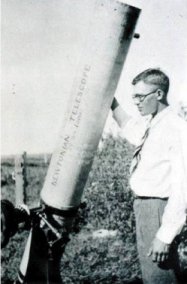 Clyde Tombaugh
(1906-1997) with the telescope he built. This was before he was hired
to look for a planet beyond Neptune.
Clyde Tombaugh
(1906-1997) with the telescope he built. This was before he was hired
to look for a planet beyond Neptune.
There are some very famous KBOs, and of course the most well known one is Pluto, which was named after the god of the Underworld. Pluto is so far from the Sun that it takes about 249 years to complete one orbit. It was discovered in 1930 by Clyde Tombaugh. At the time people thought that Neptune's orbit was being altered by another planet and Clyde Tombaugh was hired by Lowell observatory to search for the unseen planet. As you'll see, Pluto is too small to alter Neptune's orbit, and the unusual motions have been explained without the need for another planet. Pluto is so far from us that it wasn't until 1978 that its largest satellite was discovered. The satellite is named after the ferryman of the underworld, Charon. And over the years four more satellites were discovered. For the story of Pluto's discovery, follow this link.
Not much was known about Pluto due to its great distance. But that all changed in 2015 when the New Horizons spacecraft successfully flew past Pluto and obtained our first high resolution images of this small world and its moons. This mission provided images of not only Pluto but also Charon. The final results of the fly-by have yet to be released, but a few things were obvious -
Pluto in true-color (click for a larger version. |
Charon in true-color (click for a larger version. |
| Images from NASA/Johns Hopkins University Applied Physics Laboratory/Southwest Research Institute |
Prior to this flyby, we knew that the Plutonian system is tilted over like the Uranian system - Pluto is on its side and its satellites are in a tilted orbit. This is actually a good thing, since not too long ago Pluto and Charon were orientated in such a way that they would eclipse each other. Why is that important? The sizes (radii) of the objects can be learned from eclipses, and using Kepler's laws, we can get their masses. This information can give clues as to the densities and likely compositions of not only Pluto and Charon, but also of other Kuiper Belt Objects. We know that Pluto and Charon are very similar in terms of their sizes. Pluto is only eight times the mass of Charon (for comparison, the Earth is 80 times the mass of the Moon). Pluto is also only about two times wider than Charon. Some people have referred to this system as a binary system, since the two objects are relatively close in size, though with the other satellites, this isn't really the case. They are rather different in density, though. Charon's density is a bit lower than Pluto's, indicating that perhaps it formed in a similar manner to how our Moon formed, as a big impact event.
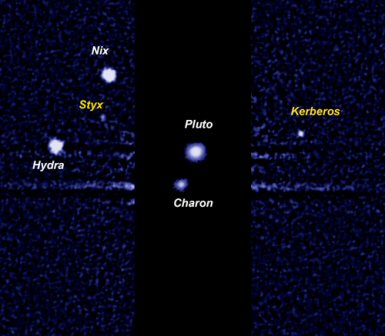 Figure 10. Hubble Space Telescope image of Pluto and its family of satellites.
Image credit: NASA, ESA, and M. Showalter (SETI Institute)
Figure 10. Hubble Space Telescope image of Pluto and its family of satellites.
Image credit: NASA, ESA, and M. Showalter (SETI Institute)
A rather nifty aspect of Pluto-Charon is that both objects are tidally locked - one side of Pluto faces Charon and one side of Charon faces Pluto. This also has the rather nifty aspect that the time for a month on Pluto (the time for the satellite to orbit) is equal to a day on Pluto (the time for the planet to rotate). This is about 6.4 Earth days. If you were to stand on the surface of Pluto, the view of Charon would be great - it would be about 10 times wider in appearance than our Moon - very romantic! Odds are the other satellites are also locked to Pluto, but since they are so small it is difficult to determine if that is the case.
The densities of Pluto and Charon are similar to the ice/rock mixture that is seen in the moons of the outer planets. Pluto has a very thin atmosphere made up mainly of nitrogen and methane. The atmosphere is only present around the time of perihelion. This is when it is close enough to the Sun that some of the surface ices can melt and become gaseous. Most of the time, Pluto doesn't have an atmosphere. And it is also pretty cold, on average around 40 K. It appears that there is also some wind in this atmosphere which may effect the surface features on Pluto.
Currently, the largest Kuiper Belt object known is Eris (formerly known as 2003 UB313), which is about 2600 km wide. Pluto, in comparison, is about 2,370 km wide - large, but not larger. Eris is really the one that got Pluto kicked out of the planet club. Not only does Eris have a larger diameter, but observations of its moon reveal that its mass is about 27% greater than Pluto. So if Pluto is a planet, some people thought, then Eris should also be a planet. But where does one draw the line? That's why there was all of that debate in the summer of 2006 when the definition of of a planet came about. So if you are upset that Pluto is no longer officially a planet, blame it on Eris - who is appropriately named after the goddess of discord and rivalry.
Other very large KBOs have been discovered and given fun names like Quaoar, and Orcus (formerly known as 2004 DW). Observations of the surface of Quaoar indicate that the surface is icy, but that the ice is in a form that was created due to a heating and freezing mechanism. It is possible that something like an impact may have caused the heating, or perhaps some tidal forces, or maybe....who knows? The presence of this form of ice also indicates that whatever formed it happened fairly recently (only a few million years ago), so that's sort of exciting.
In 2004 the discovery of an object called Sedna was announced. This is an object that is located beyond the Kuiper Belt, in a region that's called the "inner" Oort Cloud (the animation shows a zoom-out from the inner solar system, to Sedna's orbit and finally to the inner Oort Cloud). You'll learn more about the Oort cloud in the next section, so stay tuned for that. Sedna's orbit is much more elliptical than a Kuiper Belt object and it is located well beyond the edge of the Kuiper Belt. It is larger than Quaoar though. But there are even more distant objects that we've seen. The one with the largest orbit is 2006 SQ372 (gotta love the name), which has an aphelion distance of 1570 AU, while it only gets about 24 AU from the Sun at perihelion. 2006 SQ372 is a relatively small object, only 60 or so km in size.
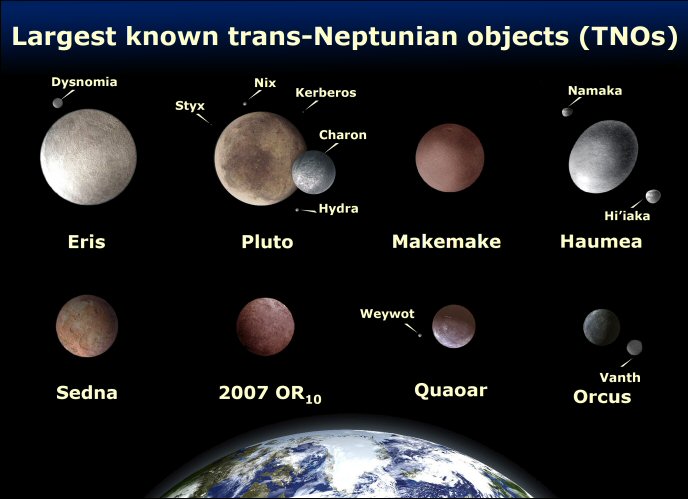 Figure 11. To scale view of various objects, including
the largest Kuiper Belt Object (Eris), as well as other objects in the outer
solar system, along with the Earth for comparison. Only
the image the Earth is accurate, while the others are artist's renditions.
The known satellites of these objects are also shown.
Figure 11. To scale view of various objects, including
the largest Kuiper Belt Object (Eris), as well as other objects in the outer
solar system, along with the Earth for comparison. Only
the image the Earth is accurate, while the others are artist's renditions.
The known satellites of these objects are also shown.
So are Kuiper Belt Objects planets? If they are, or if some of them are, where do you draw the line? Pluto was considered a planet for more than 60 years and some still consider it a planet, but if you include it, then you would have to include a whole bunch of other KBOs. If you look back at the characteristics of Terrrestrial and Jovian planets you'd see that none of the KBOs fit into that classification scheme. Sort of as a compromise, the category of dwarf planet was invented. These are objects that meet the first two criteria of "planet-hood" - they orbit the Sun and are large enough to be fairly spherical. In this group we have Pluto, Eris, two other KBOs (Haumea and Makemake), and the asteroid Ceres. So you could say we have 8+5=13 planets which can be further broken down into "regular" and "dwarf" groups, or you could just say we have 8 planets and a bunch of small stuff. Since the two types of planets, Terrestrials and Jovians, only work with 8 of these, perhaps that's the best way to distinguish those in the planet club from those not in the club.
Another name you may hear is plutoid. That refers to a dwarf planet that is located beyond Neptune, which means Eris, Makemake, Haumea and Pluto are in that group. Sort of silly, but I guess it will make the people who want to return Pluto to "full planet status" sort of happy, or maybe not.
In the next (and last) section of notes you'll learn about the rest of the stuff in the solar system. This is mainly small stuff, but as you'll see, it can have a big impact.